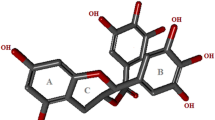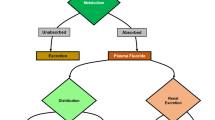Abstract
This study is aimed at determining whether royal jelly (RJ) which has a powerful antioxidant property prevents fluoride-induced brain tissue damage and exploring whether Bcl-2/NF-κB/ and caspase-3/caspase-6/Bax/Erk pathways play a critical role in the neuroprotective effect of RJ. Wistar albino rats were chosen for the study, and they were randomly distributed into six groups: (i) control; (ii) royal jelly; (iii) fluoride-50; (iv) fluoride-100; (v) fluoride-50 + royal jelly; (vi) fluoride-100 + royal jelly. We established fluoride-induced brain tissue damage with 8-week-old male Wistar albino rats by administration of fluoride exposure (either 50 mg/kg or 100 mg/kg bw) through drinking water for 8 weeks. Then, the study duration is for 56 days where the rats were treated with or without RJ (100 mg/kg bw) through oral gavage. The effects of RJ on glutathione (GSH), catalase activity (CAT), and malondialdehyde (MDA) levels were determined via spectrophotometer. Western blot analysis was performed to investigate the effects of royal jelly on the protein expression levels of Bax, caspase-3, caspase-6, Bcl-2, NF-κB, COX-2, and Erk. It was also studied the effects of RJ on histopathological alterations in fluoride-induced damage to the rat brain. As a result, the Bcl-2, NF-κB, and COX-2 protein expression levels were increased in the fluoride-treated (50 and 100 mg/kg) groups but they were decreased significantly by RJ treatment in the brain tissue. Additionally, the protein expression of caspase-3, caspase-6, Bax, and Erk were decreased in fluoride-treated groups and they were significantly increased by RJ treatment compared to the un-treated rats. Our results suggested that RJ prevented fluoride-induced brain tissue damage through anti-antioxidant activities.
Graphical abstract









Similar content being viewed by others
Data availability
Not applicable.
References
Ak S (2019) The effect of usnic acid and alfalipoic acid on bcl-2-bax changed by cadmium toxicity in liver and kidney tissue in rats. Dissertation, Kars University
Akbulut G (2019) Investigation of the effect of honey, pollen, propolıs and royal jelly extracts on the enzyme activities ofthıoredoxın reductase under in vitro conditions. Dissertation, Siirt University
Akyol E, Baran Y (2015) Structure of royal jelly, ımportance for humans and bees. Uludag Bee J 15(1):16–21
Almeer RS, Kassab RB, AlBasher GI et al (2019) Royal jelly mitigates cadmium-induced neuronal damage in mouse cortex. Mol Bio Rep 46:119–131
Aslan A, Boydak D, Can MI et al (2016a) Black cumin may be a potential drug for development of carbontetrachloride-induced lung damage in rats. Prog Nutr 18(1):56–62
Aslan A, Can MI, Kuloglu T et al (2016b) Milk thistle may induce apoptosis in development of carbontetrachloride-induced liver DNA damage in rats. Prog Nutr 18(2):146–151
Aslan A, Beyaz S, Gok O et al (2020) The effect of ellagic acid on caspase-3/bcl-2/nrf-2/nf-kb/tnf-α/cox-2 gene expression product apoptosis pathway: a new approach for muscle damage therapy. Mol Bio Rep 47:2573–2582
Aslan A, Gok O, Beyaz S et al (2020b) Ellagic acid prevents kidney injury and oxidative damage via regulation of Nrf-2/NF-κb signaling in carbon tetrachloride induced rats. Mol Bio Rep 47(10):7959–7970
Aslan A, Beyaz S, Gok O et al (2021a) The impact of ellagic acid on some apoptotic gene expressions: a new perspective for the regulation of pancreatic Nrf-2/NF-κB and Akt/VEGF signaling in CCl4-induced pancreas damage in rats. Immunopharm Immunotoxicol 43(2):145–152
Aslan A, Beyaz S, Gok O et al (2021b) Royal jelly abrogates flouride-induced oxidative damage in rat heart tissue by activating of the Nrf-2/NF-κB and Bcl-2/Bax pathway. Toxicol Mech Methods 31(9):644–654
Aslankoc R, Demirci D, Inan U et al (2019) The role of antioxidant enzymes in oxidative stress superoxide dismutase (SOD), catalase (CAT) and glutathione peroxidase (GPx). Med J Suleyman Demirel Uni 26:362–369
Beyaz S, Gok O, Aslan A (2021) The determination of the effect of curcumin on Saccharomyces cerevisiae totally protein expression changes and cell growth. Progr Nutr 23(1):e2021084
Beyaz S, Aslan A, Gok O et al (2022) In vivo, in vitro and in silico anticancer investigation of fullerene C60 on DMBA induced breast cancer in rats. Life Sci 291:120281
Cai J, Jing D, Shi M et al (2014) Epigallocatechin gallate (EGCG) attenuates infrasound-induced neuronal impairment by inhibiting microglia-mediated inflammation. J Nut Biochem 25:716–725
Demirbas DD (2020) The role of gene polymorphisms and gene expression of cytokines (tumour necrosis factor alfa (TNF-α), transforming growth factor beta-1 (TGF-β1), ınterferon gamma (IFN-Y), interleukin-6 (IL-6), and interleukin-10 (IL-10)) in the etiopathogenesis of the disease, clinical parameters and prognosis in hl patients. Dissertation, Gaziantep University
Dondossola ER, Pacheco SD, Visentin SC et al (2022) Prolonged fluoride exposure alters neurotransmission and oxidative stress in the zebrafish brain. Neurotoxicol 89:92–98
El-Sheikh AA, Kamel MY (2016) Ginsenoside-Rb1 ameliorates lithium-ınduced nephrotoxicity and neurotoxicity: differential regulation of COX-2/PGE2. Path Biomed Pharmacother 84:1873–1884
ErduranAvci D (2008) Teaching strategies for using brain hemispheres dominance. J Gazi Educat Fac 28(2):1–17
Franco R, Sanchez-Olea R, Reyes-Reyes EM et al (2009) Environmental toxicity, oxidative stress and apoptosis: menage a trois. Mutation Research/genetic Toxicol and Env Mutagen 674(1–2):3–22
Ghanbari E, Nejati V, Najafi G et al (2015) Study on the effect of royal jelly on reproductive parameters in streptozotocin-induced diabetic rats. International J Ferti Steril 9:113–120
Gokhan A, Kılıc KD, Gulle K et al (2020) Apoptotic pathways and targeted therapies. Med J Suleyman Demirel Univ 27(4):565–573
Huang KH, Fang W, Li A et al (2019) Caspase-3, a key apoptotic protein, as a prognostic marker in gastric cancer after curative surgery. Int J Surg 52:258–263
Kucukesmen C, Sonmez H (2008) Evaluation of effects of fluor on human body and teeth in dentistry. Med J Suleyman Demirel Uni 15(3):43–53
Mohamed AAR, Galal AA, Elewa YH (2015) Comparative protective effects of royal jelly and cod liver oil against neurotoxic impact of tartrazine on male rat pups brain. Acta Histochem 117(7):649–658
Narayanaswamy M, Piler MB (2010) Effect of maternal exposure of fluoride on biometals and oxidative stress parameters in developing CNS of rat. Bio Trace Elem Res 133(1):71–82
Nguyen TT, Kambe Y, Miyata A (2021) Chronic royal jelly administration ınduced antidepressant-like effects through ıncreased sirtuin-1 and oxidative phosphorylation protein expression in the amygdala of mice. Cur Mol Pharmacol 14(2):115–122
Oktay LM (2015) Investigatıon of the effects of hydroxytyrosol on cytotoxicity, apoptosis, PI3K/Akt And Erk 1/2 pathways in ovarian cancer cell cultures. Dissertation, Celal Bayar University
Pan Y, Xu J, Jin P et al (2019) Royal jelly ameliorates behavioral deficits, cholinergic system deficiency and autonomic nervous dysfunction in ovariectomized cholesterol-fed rabbits. Molecules 24:1149
Rathmell JC, Lindsten T, Zong WX et al (2002) Deficiency in Bak and Bax perturbs thymic selection and lymphoid homeostasis. Nature Immunol 3:932–939
Senli H (2013) Investigation of relationship between -1195 A>G, 8473 T>C polymorphisms of COX-2 gene and mRNA levels of COX-2 gene in human peripheral blood monocyte in colorectal cancer patients. Dissertation, Mersin University
Seymen CM, CakirGundogdu A, Bulut DI et al (2020) Royal jelly increased map-2 expression in hippocampal neurons of hypothyroid rats: an immunohistochemical study. Biotech Histochem 95(1):46–54
Shivarajashankara YM, Shivashankara AR, Bhat GP et al (2002a) Brain lipid peroxidation and antioxidant systems of young rats in chronic fluoride intoxication. Fluoride 35:197–203
Shivarajashankara YM, Shivashankara AR, Bhat GP et al (2002b) Histological changes in rat brain of young fluoride intoxicated rats. Fluoride 35:12–21
Silva TGDS, Silva JRM, Silva Alves A et al (2020) Oral treatment with royal jelly improves memory and presents neuroprotective effects on icv-STZ rat model of sporadic Alzheimer’s disease. Heliyon 6:e03281
Song Y, Zhong M, Cai FC (2018) Oxcarbazepine causes neurocyte apoptosis and developing brain damage by triggering bax/bcl-2 signaling pathway mediated caspase 3 activation in neonatal rats. Eur Rev Med Pharmacol Sci 22(1):250–261
SoukhakLari R, Borhani-Haghighi A, Farsadrooh A et al (2019) The effect of cinnamaldehyde on passive avoidance memory and hippocampal Akt, Erk and GSK-3β in mice. Eur J Pharmacol 859:172530
Teixeira RR, Souza AV, Peixoto LG et al (2017) Royal jelly decreases corticosterone levels and improves the brain antioxidant system in restraint and cold stressed rats. Neurosci Let 655:179–185
World Health Organization (WHO) (2004) Guidelines for drinking-water 427 quality (GDWQ). 1–17
Yang Y, Zhang X, Cui H et al (2014) Apelin-13 protects the brain against ischemia/reperfusion injury through activating PI3K/Akt and ERK1/2 signaling pathways. Neurosci Let 568:44–49
Zhang C, Zhu J, Zhang J et al (2014) Neuroprotective and anti-apoptotic effects of valproic acid on adult rat cerebral cortex through ERK and Akt signaling pathway at acute phase of traumatic brain injury. Brain Res 1555:1–9
Zhao Q, Wang X, Chen A et al (2018) Rhein protects against cerebral ischemic/reperfusion induced oxidative stress and apoptosis in rats. Int J Mol Med 41(5):2802–2812
Funding
Financial support was provided from the Firat University Research Projects Unit (FUBAP) [Grant No. FF.19.16].
Author information
Authors and Affiliations
Contributions
AA designed the project, coordinated the study, and drafted the manuscript. AA and SB wrote the article, review-editing. SB, OG, MIC, GP, IHO, CAA, and AEP carried out the experiments, participated in data analysis, and contributed to the interpretation of the results. CAA took the lead in review editing the manuscript. All authors gave critical feedback and approved the final manuscript.
Corresponding author
Ethics declarations
Ethics approval and consent to participate
The animal study was conducted in accordance with international (the Declaration of Helsinki), Turkish national legislation and local guidelines and performed at Experimental Animals Research Center, affiliated to School of Medicine, Firat University. The local animal ethics committee approved the experimental protocol (Ethical Issue No. 2020/11, Dated on 20/08/2020, Elazig, Turkey). All efforts were adopted to handle the rats humanely and to achieve ethical rules.
Consent for publication
The authors declare that they consent for the publication of this study.
Competing interests
The authors declare no competing interests.
Additional information
Responsible Editor: Mohamed M. Abdel-Daim
Publisher's note
Springer Nature remains neutral with regard to jurisdictional claims in published maps and institutional affiliations.
Some parts of the results of this manuscript were submitted orally at the 2nd International Congress on Medical Sciences and Biotechnology (1–3 October 2020, 303, Usak, Turkey) and Mas 14th International European Conference on Mathematics, Engineering, Natural & Medical Sciences (26–28 March 2021, Széchenyi István University, Hungary).
Rights and permissions
Springer Nature or its licensor (e.g. a society or other partner) holds exclusive rights to this article under a publishing agreement with the author(s) or other rightsholder(s); author self-archiving of the accepted manuscript version of this article is solely governed by the terms of such publishing agreement and applicable law.
About this article
Cite this article
Aslan, A., Beyaz, S., Gok, O. et al. Royal jelly protects brain tissue against fluoride-induced damage by activating Bcl-2/NF-κB/caspase-3/caspase-6/Bax and Erk signaling pathways in rats. Environ Sci Pollut Res 30, 49014–49025 (2023). https://doi.org/10.1007/s11356-023-25636-y
Received:
Accepted:
Published:
Issue Date:
DOI: https://doi.org/10.1007/s11356-023-25636-y




